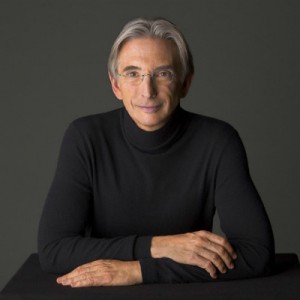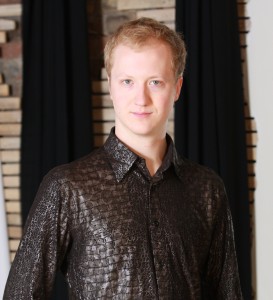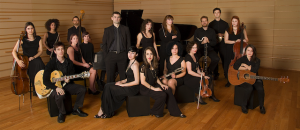 I was sitting in the S21 headquarters–Starbucks on 57th Street between Eighth and Ninth Avenues–sipping a latte and trying to guess which of the several attractive Asian-American women in the room was Sugar Vendil, founder/artistic director/pianist of The Nouveau Classical Project, when a helpful message popped up on my iPhone: “I’m the one with the black bowties on my shoes,” it said. But, of course, I thought, that makes perfect sense. This is a woman who has been producing three or four concerts a year since 2008 that bring together the unlikely combination of composers, performers and fashion designers to create performances that are as much fun to look at as they are to listen to. Of course, she wears bowties on her shoes.
I was sitting in the S21 headquarters–Starbucks on 57th Street between Eighth and Ninth Avenues–sipping a latte and trying to guess which of the several attractive Asian-American women in the room was Sugar Vendil, founder/artistic director/pianist of The Nouveau Classical Project, when a helpful message popped up on my iPhone: “I’m the one with the black bowties on my shoes,” it said. But, of course, I thought, that makes perfect sense. This is a woman who has been producing three or four concerts a year since 2008 that bring together the unlikely combination of composers, performers and fashion designers to create performances that are as much fun to look at as they are to listen to. Of course, she wears bowties on her shoes.
Sugar–a combination of Suzanne and Edgar, her parents’ names–is a 29-year-old Filipino-American from the Bay Area who started playing the piano at 3 1/2 but didn’t get really serious until she heard a classmate playing Lizst’s Hungarian Rhapsodies–the one made famous by Bugs Bunny–at around 6. She knew immediately it was time to step it up a notch.
“I didn’t have the typical Asian ‘Tiger Mom’ or anything like that,” Sugar says. “My parents were more laid back. They never pressured me at all. If I practiced a lot it was because I wanted to practice. They let me develop at my own pace and I’m was happy for that.”
Sugar arrived in New York in 2001, enrolled at NYU, and settled into life in the music and fashion capitals of the world. She has posed for fashion shoots herself and admits that “fashionista” is not a term often used to describe most denizens of the new music demimonde where geekiness is often the aspired to look. But she sees nothing strange about inviting emerging designers to create clothing that matches the music program.
“Music and fashion have always been my passions,” she says. “I see fashion as simply another way of expressing myself. The idea of combining classical music with creative clothing may sound a little superficial but it’s really not. We play serious music at our concerts but the fashion elements add touches of theater and style and provide some context for the music we’re playing.”
Case in point: The Nouveau Classical Project’s next concert at Symphony Space on Thursday, April 5 is a salon event, Wearing the Lost Generation which Sugar describes as a “reimagining the Parisian Avant Garde.” The musical program is Ravel’s Piano Trio in A minor and the world premiere of Lost Generation, an electro-acoustic work by Trevor Gureckis. The performers will be wearing music-inspired pieces by milliner and designer Heidi Lee, who has a reputation for producing “quirky” hats. St-Germain is sponsoring the post show reception with complimentary cocktails.
Like so many young people with vision who come to New York determined to make an impression, Sugar is tireless in her ambitions. She organizes The Nouveau Classical Project programs, comes up with themes, finds the venues, finds the right designers and composers, selects the programs, and usually does the promotion. This is not even to mention the rehearsals needed to play professional level concerts in public. I asked her if with all that she still had time for a personal life. She assured me that she does.
“I have a boy friend that I’m crazy about and I play a mean game of volleyball,” she says. With that, she dashed off to tackle Ravel. Poor man doesn’t have a chance.


 This weekend, the Austin New Music Co-op celebrates its 10th year of wild music with two nights of concerts. The programs will function partly as a retrospective on those years, reprising some of their most ambitious and unique projects, like last year’s massive US premiere of Cornelius Cardew’s “The Great Learning” (excerpted now with the Texas Choral Consort). Other group milestones on the program include:
This weekend, the Austin New Music Co-op celebrates its 10th year of wild music with two nights of concerts. The programs will function partly as a retrospective on those years, reprising some of their most ambitious and unique projects, like last year’s massive US premiere of Cornelius Cardew’s “The Great Learning” (excerpted now with the Texas Choral Consort). Other group milestones on the program include:

